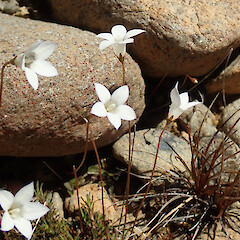Wahlenbergia albomarginata subsp. olivina
Common name
Red Hills harebell, Mt Dun harebell
Synonyms
None (first described in 1997)
Family
Campanulaceae
Flora category
Vascular – Native
Endemic taxon
Yes
Endemic genus
No
Endemic family
No
Structural class
Herbs - Dicotyledons other than Composites
Chromosome number
2n = 36
Current conservation status
The conservation status of all known New Zealand vascular plant taxa at the rank of species and below were reassessed in 2017 using the New Zealand Threat Classification System (NZTCS) – more information about this can be found on the NZTCS website. This report includes a statistical summary and brief notes on changes since 2012 and replaces all previous NZTCS lists for vascular plants.
Please note, threat classifications are often suggested by authors when publications fall between NZTCS assessment periods – an interim threat classification status has not been assessed by the NZTCS panel.
- Conservation status of New Zealand indigenous vascular plants, 2017 . 2018. Peter J. de Lange, Jeremy R. Rolfe, John W. Barkla, Shannel P. Courtney, Paul D. Champion, Leon R. Perrie, Sarah M. Beadel, Kerry A. Ford, Ilse Breitwieser, Ines Schönberger, Rowan Hindmarsh-Walls, Peter B. Heenan and Kate Ladley. Department of Conservation. Source: NZTCS and licensed by DOC for reuse under the Creative Commons Attribution 4.0 International licence.
2017 | At Risk – Naturally Uncommon | Qualifiers: RR, Sp
Previous conservation statuses
2012 | At Risk – Naturally Uncommon | Qualifiers: RR, Sp
2009 | At Risk – Naturally Uncommon
2004 | Range Restricted
Distribution
Endemic. New Zealand: South Island (serpentine areas from Dun Mountain to the Red Hills, Richmond Range)
Habitat
Montane. Confined to serpentinite open rock, scree, bare soils and within open shrubland.
Detailed description
Perennial herb with radical, rosulate tufts of leaves, sometimes alternate on elongated stems (shade form). Leaves dark olive green to red-green above, usually purple beneath, more or less petiolate, entire inconspicuously dentate, lamina 10 × 2 to 40 × 10 mm, linear to elliptic or ovate to obovate, gradually narrowed to petiole as long as the lamina or longer, margins cartilaginous, upper surface bearing sparse to numerous white, stiff bristly hairs. Flowers insect-pollinated, narrowly campanulate-rotate, corolla pale flax blue to pale blue-violet, often with white zoning and deeper coloured veins, or all white, 10-30 mm diameter, 10-20 mm long, corolla tube 4 × 3 to 10 × 6 mm, lobes 6 × 3 to 12 × 5 mm; style equal in length to corolla tube, lobes 2 or 3. Calyx lobes less than ¼ corolla length; capsule domed cylindric, 6-8 × 4 mm. Seeds 0.5 mm long, ellipsoid, smooth, glossy brown when mature.
Similar taxa
Similar to subsp. albomarginata, but differing by its restriction of ultramafic habitats, dark olive green to red-green leaves bearing on the upper surface numerous to sparse white, stiff bristly hairs; often purple leaf undersides; and by the prominent cartilaginous margins.
Flowering
November – April
Flower colours
Blue, Violet/Purple
Fruiting
December - April
Propagation technique
Easily grown from tip cuttings and the division of whole plants. Fresh seed germinates readily. Being insect-pollinated and having an indigenous pollinator, cultivated plants rarely set seed.
Threats
A naturally uncommon. range restricted species abundant throughout its known habitats. There are no obvious threats.
Etymology
wahlenbergia: Named in honour of Wahlenberg, a Swedish botanist and author of A Botany of Lapland.
albomarginata: From the Latin albus ‘white’ and marginatus ‘having a border or margin’ meaning something with a white margin, often referring to leaves
Where To Buy
Not Commercially Available
Attribution
Fact Sheet Prepared by P.J. de Lange (12 June 2007). Description adapted from Petterson (1997).
References and further reading
Petterson, J.A. 1997: Revision of the genus Wahlenbergia (Campanulaceae) in New Zealand. New Zealand Journal of Botany 35: 9-54.
NZPCN Fact Sheet citation
Please cite as: de Lange, P.J. (Year at time of access): Wahlenbergia albomarginata subsp. olivina Fact Sheet (content continuously updated). New Zealand Plant Conservation Network. https://www.nzpcn.org.nz/flora/species/wahlenbergia-albomarginata-subsp-olivina/ (Date website was queried)









